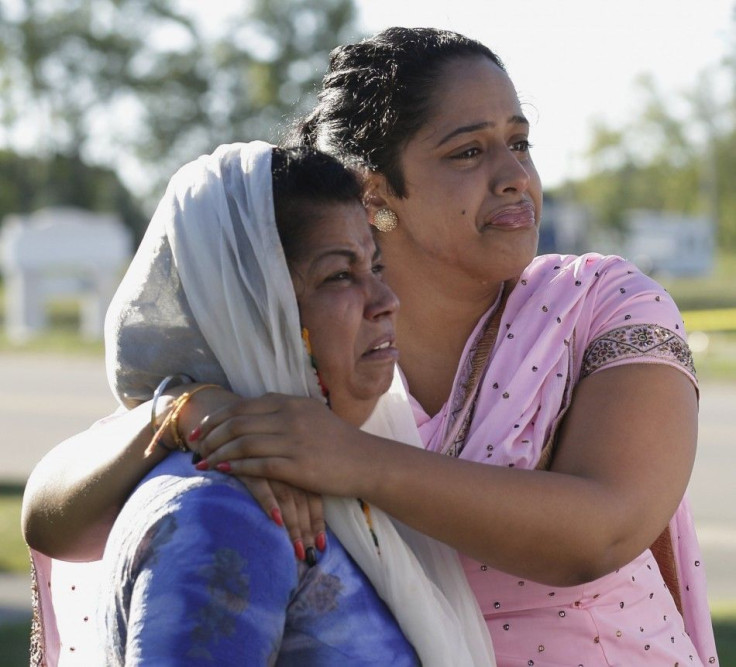Wisconsin Temple Shootings Media Coverage Criticized For Lacking The Outrage Of Aurora Massacre

The shooting rampage that left seven people dead at a Sikh temple in Oak Creek, Wis., on Sunday has prompted misinformation, sloppy reporting and outright ignorance about the Sikh religion, some media professionals are charging.
On the left-leaning blog Liberal Conspiracy, the British journalist Sunny Hundal posted a derisive recap of what he referred to as "awful" U.S. media coverage of the shootings. Hundal cites, for instance, a Fox News reporter who asked a distraught Sikh if there had been other "anti-Semitic" acts against the Sikh community. Hundal also reposted a tweet that called out a CBS reporter who made this observation: "The Sikh religion is based around truth and nonviolence and the Muslim religion is just a completely different religion."
Over at Buzzfeed, Andrew Kaczynski posted similar criticisms, taking CNN's Eric Marrapodi to task for saying that Sikhs are sometimes "unfairly" mistaken for Muslims. "Seems to imply it's fair to target Muslims," Kaczynski tweeted.
Then there was Fox 6 News in Milwaukee, which reported that the Sikh religion is based in northern Italy.
On Sunday, the Asian American Journalists Association (AAJA) released a media advisory that offers guidelines for journalists reporting on the tragedy. Doris Truong, the organization's national president, said the advisory wasn't a response to specific instances of poor coverage, but rather an effort to share accurate information.
"We were just trying to be proactive," she said in a phone interview. "We offer these types of guidelines whenever a national negative event takes place that affects people we consider to be part of the Asian American or Pacific Islander community."
Truong recalled two previous incidents that necessitated such advisories. The first was in 2007, when Seung-Hui Cho shot and killed 32 people at Virginia Tech. The second was in 2010, when James Jay Lee took three people hostage at the headquarters of Discovery Communications in Silver Spring, Md., before being gunned down by authorities.
In the wake of the temple shootings, AAJA's advisory provides basic information and statistics about Sikhism and Sikh Americans -- a segment of the population Truong believes Americans would know much more about if mainstream media outlets took steps to increase awareness. "This is a community that is under-covered," she said. "And it's unfortunate that it takes a negative event like this to bring that to light."
AAJA's advisory was first posted on Aug. 5, but it was updated after the group received feedback from the Sikh Coalition, a New York-based civil rights group that Truong said was "concerned with some of the wording." The Sikh Coalition was created in 2001, following increased "bigotry, violence and discrimination" against New York City's Sikh population in the aftermath of the Sept. 11 terrorist attacks.
Wade Michael Page, the suspected shooter in Sunday's attacks who was gunned down by police, had apparently been a member of a white-power skinhead band. However, his motivation for the shootings remains unclear. Some media professionals, meanwhile, have pointed to a stark difference in the amount of coverage the temple shootings have received versus the shootings at "The Dark Knight Rises" screening in Aurora, Colo., a few weeks ago. Huffington Post editor Riddhi Shah on Monday criticized the mainstream media for not providing the same kind of "around-the-clock" coverage that had newscasters reserved for the earlier tragedy. "This time, there was none of that," she wrote. "Instead, TV commentators asked tentative questions about a religion that few had heard of. There was none of the sense of outrage that followed the Aurora massacre, none of the national heartbreak and grief that seemed so pervasive only two weeks ago."
According to the Sikh Coalition, there are about 25 to 30 million Sikhs worldwide, but only about 500,000 living in the United States. The vast majority of Sikhs live in India. Sikhism was founded in South Asia in 1469, and it is the world's fifth-largest religion. Sikh men are religiously mandated to wear Sikh turbans, called dastaars, and maintain unshorn hair and facial hair. Observant Sikh women are also religiously mandated to maintain uncut hair.
AAJA's media advisory on coverage guidelines for the temple shootings was compiled from its "Handbook to Covering Asian America." Although Truong laments that so many media groups lack the basic information necessary to offer proper coverage of the Sikh community, she did not seem surprised by the media gaffes that have unfolded over the last few days. "Newsrooms should have knowledgeable journalists who are prepared to cover every religion, but that's not the case," she said. "I think we have a situation now where a lot of media outlets are asking themselves, 'Well, what do we know about Sikhism?'
© Copyright IBTimes 2024. All rights reserved.






















